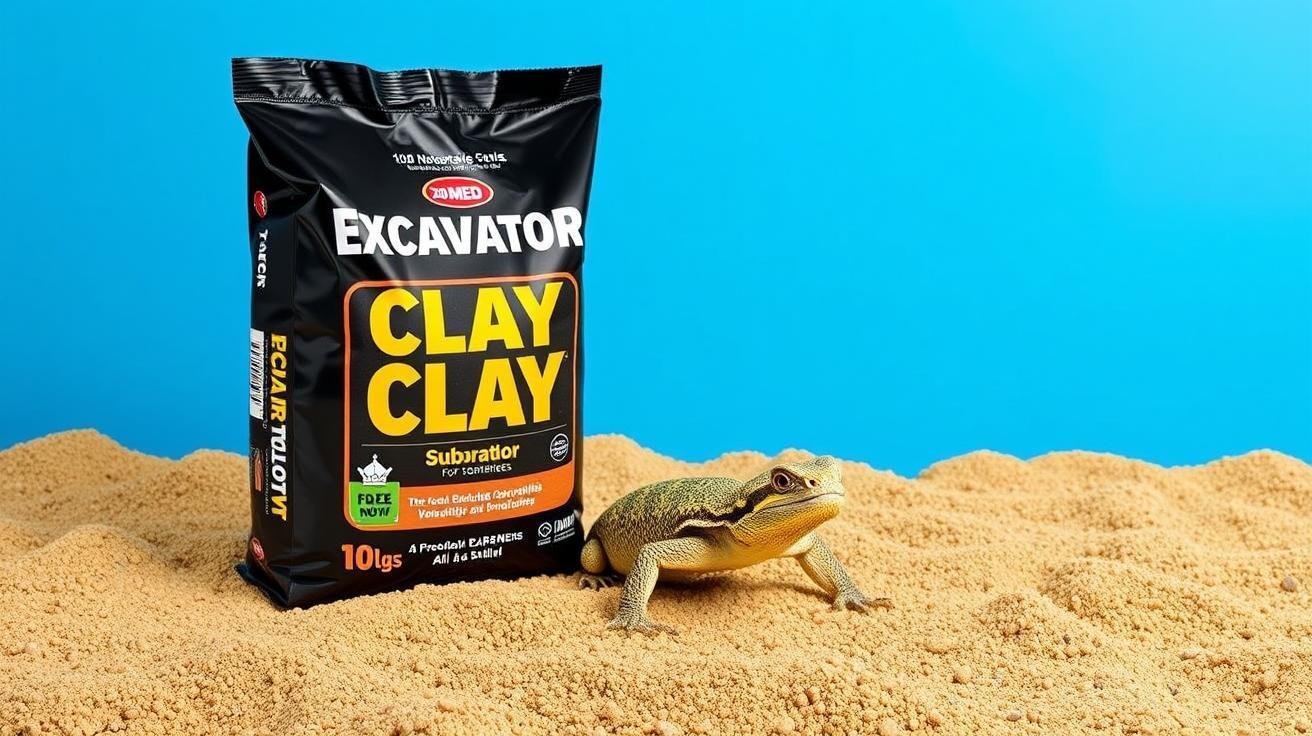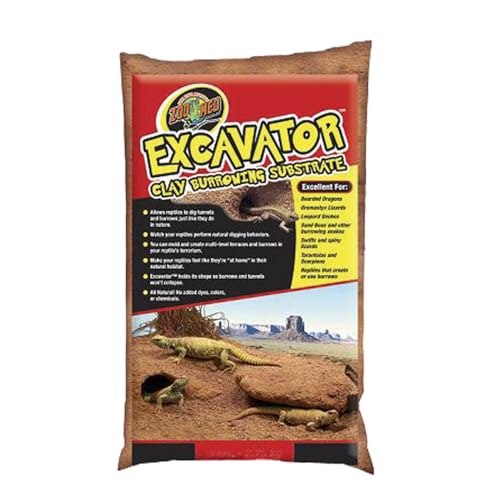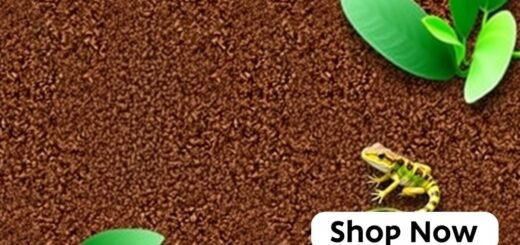Zoo Med Excavator Clay Review: Pros, Cons & Verdict

Zoo Med Excavator Clay Review: Unleash Your Reptile’s Inner Engineer?
Welcome, fellow herp enthusiasts! If you’ve ever watched a nature documentary and seen a lizard disappear into an intricate, self-made burrow, you’ve witnessed one of the most fundamental instincts of many reptile species. Providing an environment that encourages these natural behaviors is one of the most rewarding aspects of reptile keeping. But how do you replicate that in a glass terrarium? Loose sand collapses, and standard substrates don’t hold a shape. It’s a common dilemma for keepers of fossorial (burrowing) species.
Enter the Zoo Med Excavator Clay Burrowing Substrate. This product promises to be the solution, a moldable clay that allows you to—and more importantly, your reptile to—create stable tunnels, caves, and terraces. But does it live up to the hype? Is it safe, practical, and truly enriching for our scaly friends? I got my hands on a 10 lbs bag to find out. In this deep-dive review, we’ll dig into every aspect of this popular substrate to help you decide if it’s the right choice for your terrarium setup.
Key Takeaways
- Encourages Natural Behavior: Successfully allows reptiles to dig and create burrows that hold their shape, providing crucial mental and physical enrichment.
- Highly Moldable: When mixed with water, it transforms into a versatile clay that you can sculpt into caves, tunnels, and multi-level landscapes.
- Durable Once Dry: The structures become rock-hard and stable after drying, preventing collapses and ensuring your pet’s safety inside their burrows.
- All-Natural: Contains no dyes, added colors, or chemicals, making it a safe choice for your pet’s environment.
- Requires Prep Work: This is not a ‘pour and go’ substrate. It requires mixing with water and a significant drying period (24-72 hours) before your reptile can be introduced.
- Holds its shape so tunnels won’t collapse
- All natural, no dyes or chemicals
- Make your reptiles feel like they are at home” in their natural habitat”
The Bottom Line: Our Verdict
After extensive testing and observation, my take is that the Zoo Med Excavator Clay is a game-changing product for the right keeper and the right reptile. It’s not just a substrate; it’s a habitat-building tool. For arid and semi-arid species that naturally burrow—like Leopard Geckos, Uromastyx, and certain Monitor species—it provides an unparalleled level of enrichment. The ability for them to dig their own tunnels that *actually stay put* is incredible to watch and vital for their well-being.
However, it’s not a universal solution. It demands patience during setup, a keen eye on humidity levels, and isn’t suitable for high-humidity tropical setups. If you’re willing to put in the initial effort of mixing, molding, and waiting for it to dry, the payoff is a dynamic, functional, and naturalistic environment that most other substrates simply can’t replicate. It’s an excellent piece of essential gear for keepers focused on behavioral enrichment.
Essential Features & Benefits: A Closer Look
Let’s break down what makes this clay substrate stand out. It’s more than just dirt in a bag; its properties are specifically engineered for herpetoculture.
Create Your Own Tunnels and Burrows
The primary selling point is, without a doubt, its ability to hold a shape. When mixed to the right consistency (think thick, packable mud), you can build incredible structures. I started by creating a foundational hide by packing the clay over a small balloon. Once it dried, I popped the balloon, and voilà—a perfect, solid cave. The real magic, though, happens when you let your animal take over. My Uromastyx, who previously just bulldozed loose sand, began actively digging and extending a starter burrow I made. This isn’t just decoration; it’s interactive and stimulating for the animal.
Exceptional Structural Integrity When Dry
Safety is paramount, and the fear of a burrow collapsing on a pet is a real concern with DIY setups. One thing I noticed right away is how rock-solid this stuff becomes once fully cured. I applied significant pressure to the dried structures, and they didn’t budge. This stability gives you peace of mind that the tunnels and caves your reptile uses are secure. This safe and durable quality means you can create multi-level terraces without worrying about them eroding or falling over time.
All-Natural Composition
In an industry where artificial products are common, it’s refreshing to see a substrate that is simply… clay. There are no added dyes, paints, or synthetic binders. This is hugely important, as our pets live on and in this material 24/7. The natural red-orange hue gives the terrarium a beautiful, authentic desert look. You can rest easy knowing your pet isn’t being exposed to unnecessary chemicals, making it a solid choice among pet supplies focused on animal welfare.
Who Is This Substrate For?
This product truly shines for specific types of reptiles and keepers:
- Arid and Semi-Arid Species: It’s a fantastic match for desert dwellers like Leopard Geckos, Bearded Dragons (especially those that enjoy digging), Uromastyx, Collared Lizards, and smaller monitor species like Ackie Monitors.
- Creative Keepers: If you enjoy the aquascaping or ‘vivarium-building’ aspect of the hobby, you will have a field day with this stuff. It’s a blank canvas for creating stunning, functional landscapes.
- Enrichment-Focused Owners: For those who prioritize providing outlets for natural behaviors, this substrate is a must-have for reptiles and amphibians that burrow. It goes beyond basic husbandry and into the realm of behavioral enrichment.
- It is NOT for: Tropical species requiring high humidity (it can get muddy or moldy if kept constantly wet) or species prone to severe impaction from ingesting any substrate. Always research your specific animal’s needs.
Pros & Cons at a Glance
Pros / Highlights
- ✔️ Unmatched for creating stable burrows and tunnels.
- ✔️ Encourages natural, instinctual digging behaviors.
- ✔️ Dries rock-hard, ensuring structural safety.
- ✔️ All-natural and free from harmful chemicals or dyes.
- ✔️ Aesthetically pleasing, creates a realistic desert look.
Potential Drawbacks / Cons
- ❌ Labor-intensive initial setup (mixing, molding).
- ❌ Long drying time required (can be 1-3 days).
- ❌ Can be quite dusty when dry and during mixing.
- ❌ Difficult to spot clean; may require partial or full replacement for deep cleaning.
- ❌ Can retain some humidity, so requires good ventilation.
Tips for Success: Getting the Most Out of Your Excavator Clay
To be honest, your first time using this can be a bit of a learning curve. Here are a few tips I picked up:
- Mix It in a Separate Bucket: Don’t just dump the bag and water into your terrarium. Mix it externally in a large bucket or tub. It’s messy, but it gives you much better control over the consistency.
- Start with Less Water: You can always add more water, but you can’t take it away. Add water slowly until you get a thick, oatmeal-like consistency that holds its shape when you squeeze it. Too wet, and it will slump; too dry, and it will be crumbly.
- Use Tools: Use balloons, PVC pipes, or crumpled-up plastic wrap to form the internal shapes of your caves and tunnels. Once the clay is dry, you can easily remove these ‘molds’.
- Be Patient with Drying: Use a fan pointed at the enclosure (with the lid off) to speed up the drying process. Do not add your animal until the substrate is completely dry to the touch, all the way through. This is crucial to prevent humidity spikes and health issues.
Frequently Asked Questions
1. How much water do I need to mix with a 10 lbs bag?
There’s no exact formula, as it depends on your ambient humidity. The general guideline is to start with about 1.5 to 2 liters of water for a 10 lbs bag. The key is to add it slowly while mixing until you achieve a packable, non-soupy consistency. It should feel like very thick, gritty dough.
2. Is Zoo Med Excavator Clay safe if my reptile eats it?
While it’s an all-natural clay, no substrate is 100% impaction-proof. The risk with Excavator Clay is generally considered low for healthy, properly hydrated animals with correct husbandry (especially proper heating for digestion). When dry, it’s too hard to eat. During a feeding response, an animal might accidentally ingest a small amount if a feeder is on the substrate. The best practice is to feed your reptile in a separate dish or tong-feed to minimize this risk, which is a good habit regardless of the substrate you use.
3. How do you clean the Excavator Clay substrate?
This is one of the main challenges. Spot cleaning is difficult because the surface is hard. You can scrape off surface waste, but for deeper messes, you may need to chip away a section and patch it with a small, newly-mixed batch of clay. For a full deep clean, the entire substrate usually needs to be broken up and replaced. Many keepers use a bioactive-style cleanup crew (like isopods and springtails) in a top layer of leaf litter over the clay to help manage waste.
4. Can I add it to an existing setup with my pet inside?
Absolutely not. The wet clay will create a massive humidity spike, which can cause respiratory infections in arid species. The animal must be housed in a temporary enclosure while the clay is added, sculpted, and dries completely, a process that can take up to 72 hours.
Final Thoughts & Wrap-Up
The Zoo Med Excavator Clay Burrowing Substrate is far more than just a floor covering for your terrarium. It’s an enrichment tool, a creative medium, and a pathway to observing your reptiles’ incredible natural instincts up close. It requires a bit of elbow grease and planning to implement correctly, but the results can be truly spectacular.
In fact, seeing an animal you care for actively modifying its own environment, creating a home for itself, is one of the most fulfilling experiences a keeper can have. While it has its drawbacks—namely the complex setup and cleaning—its benefits for the mental and physical health of burrowing species are undeniable. If you’re ready to graduate from simple, flat substrates and build a truly dynamic, three-dimensional habitat for your desert-dwelling reptile, this product is an outstanding choice and gets a strong recommendation from me.




